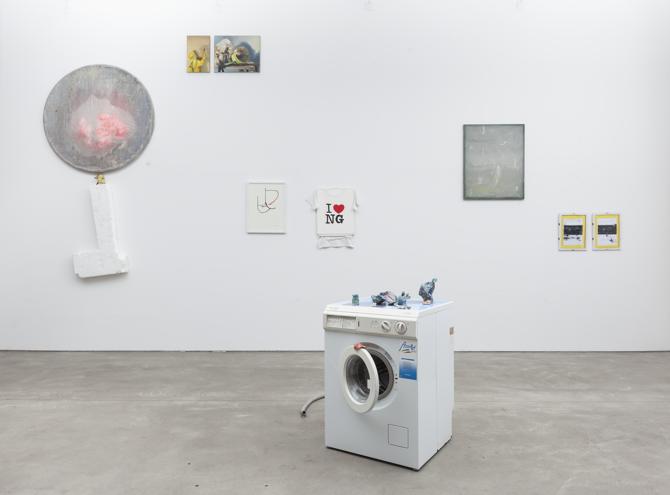
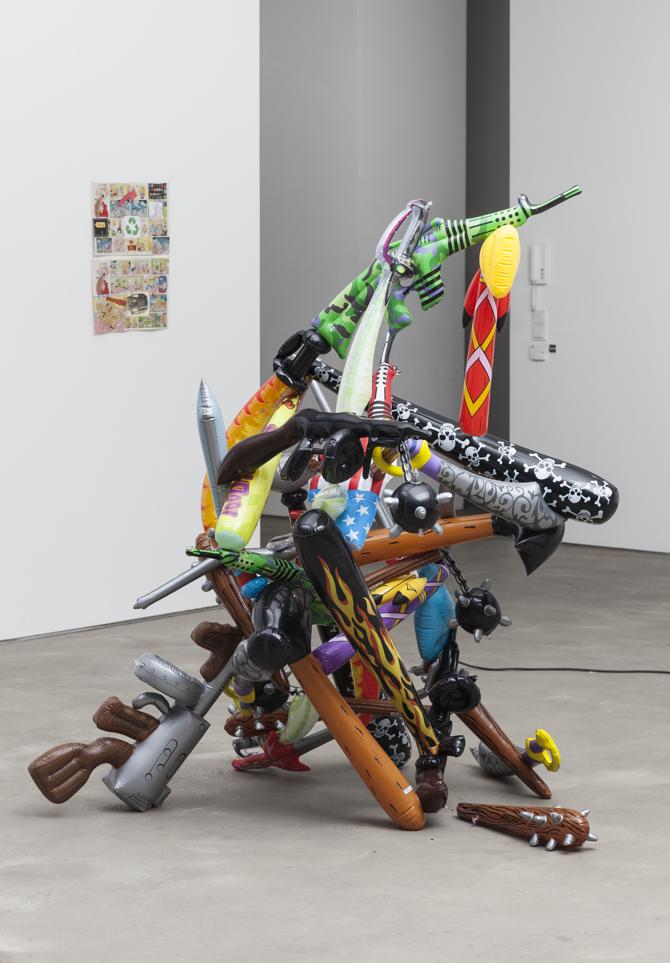
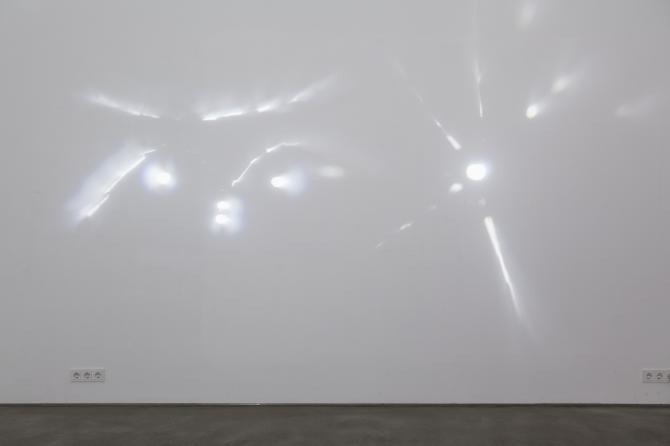
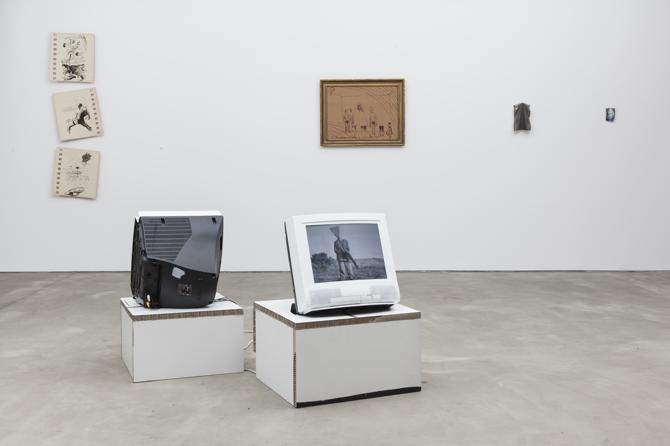 all images: installation views, BATMAN ELEKTRONIK, Galerie Mikael Andersen Berlin, Curated by Fritz Bornstück & Ernst Markus Stein, photos and courtesy Galerie Mikael Andersen
all images: installation views, BATMAN ELEKTRONIK, Galerie Mikael Andersen Berlin, Curated by Fritz Bornstück & Ernst Markus Stein, photos and courtesy Galerie Mikael Andersen
How does technology influence our lives? How does a super hero of the 21st century look like? Is there still space for humanity and sexuality? The artists and curators Ernst Markus Stein and Fritz Bornstück invited 31 contemporary artists to discuss these questions along their artistic practice and strategies. “Batman Elektronik”, the current exhibition at Galerie Mikael Andersen Berlin, tells stories about the post-internet generation from various angles and pleads for a well grounded handling in technology. We met Fritz and Markus to learn about their motivation and how the exhibition concept originated.
Anna-Lena Werner: Fritz and Markus – you are the curators of the current group show “Batman Elektronik”. How did the exhibition’s title come about?
Ernst Markus Stein: The title and the logo come from a shop in Neukölln, where you could buy computers or get them repaired. They moved into a larger place, so the old store was vacant for months. We know the shop owner and asked him, if we could arrange a show in the empty space, but he refused. Instead, he made an exhibition two weeks later with his own sculptures made of electronic waste and we relocated to Galerie Mikael Andersen.
Anna-Lena Werner: Did you invite the shop owner to the exhibition?
Ernst Markus Stein: Yes, we did. He even designed one of the catalogues’ covers, with an aesthetic that is similar to mid-nineties cyber punk.
Fritz Bornstück: It is the one with the circuit board.
Anna-Lena Werner: You are both artists. Which criteria defined your selection of participating artists for the exhibition?
Fritz Bornstück: Batman functions as a theme, whereas the basic idea was to assemble artists from our generation, who already developed strategies of approaching the relationships between technology, humanity, super heroes and sexuality. Andy Hope 1930 and Frieder Butzmann belong to an older generation and some other artists are fairly new to the theme – here it was interesting for us, how they would adapt to the topic.
Anna-Lena Werner: “Batman Elektronik” includes almost every artistic medium. Was it important to you that there is no emphasis on a specific genre?
Fritz Bornstück: Yes, the plan was to avoid a consensus in both, media and aesthetic.
Ernst Markus Stein: This obviously influenced our choice of artists, but I would not call it a concept.
Fritz Bornstück: I am interested in fruitful confrontations. For example, having contrary artists such as Simon Schäfer and Sebastian Meschenmoser in one exhibition space: While Simon and his multi-media material are a prime example for the theme, Sebastian mostly works on panel paintings and recently produced a series of science-fiction paintings.
Anna-Lena Werner: Does “Batman Elektronik” depict a refracted super hero or does it seek to reanimate the figure?
Ernst Markus Stein: I would say it is about reanimation. Even though, a hero is simply produced from the outside. And the idea of the anti-hero is not that far either.
Fritz Bornstück: I think it is about the human being...
Anna-Lena Werner: ...the one, under the mask?
Fritz Bornstück: Yes, and also the one, who wishes for a super hero to exist. Or the human being, who seeks to position himself in the online world in a period of post-internet.
Anna-Lena Werner: Does “Batman Elektronik” point to an utopian or a dystopian future?
Ernst Markus Stein: There is both. I think what interests us is how humanity changes with an increasingly technical world – how does it influence sexuality, interfere in relationships, and the image of the super hero? There are still so many insecurities – technology is still new: Society still needs a couple of years to understand it. Maybe this is the super hero we are looking for: someone who can handle technology.
Fritz Bornstück: I think it is neither nor. Dystopia is also a corny idea that everybody loves. Since the 80s, movies have portrayed technology in a dystopian manner. “Blade Runner”, “Terminator”, “Matrix” – they all portray the natural human being in an environment of technology.
Anna-Lena Werner: In these movies, technology is often depicted as an evil enemy that takes control and withdraws freedom...
Fritz Bornstück: ...True. Even though, in the last Batman movie it was quite the opposite. Batman needed a technical armour in order to be strong. Without the armour, he would have been a cripple. So here, technology is the good.
Anna-Lena Werner: This scenario conforms to Marshall McLuhan’s idea of technology being an extension of the human being. In your personal opinion: Is technology our enemy or our friend?
Ernst Markus Stein: It certainly is our friend.
Fritz Bornstück: In the end, the complete organisation of this exhibition was done through technology – via mail, internet, facebook. The interesting part is to use technology and bring it into reality – the printed catalogue for example.
Anna-Lena Werner: Besides inviting each of the artists to design an individual catalogue cover, a striking part of the exhibition is a small library, installed in the rear space of the gallery. Why did you decide to integrate a reading corner?
Fritz Bornstück: To give visitors an opportunity to immerse themselves in the artworks and to read through various catalogues by the participating artists. I personally find it disappointing when galleries do not provide enough background information.
Ernst Markus Stein: It raises questions on how artists are being represented by galleries and museums. Some of these artists are musicians, some do completely different jobs next to their art. We wanted to present more facets of their practice.
Fritz Bornstück: For the other part of the library we invited the artists to bring books, which are important for their work and influential for their development. Even though it was an experiment, it worked very well and many visitors spend their time looking through the books.
Anna-Lena Werner: Would you agree that the set-up of “Batman Elektronik” appears like a plea for deceleration and leisure?
Ernst Markus Stein: Definitely. In addition to humanness, this show is certainly about slowness, too.
Fritz Bornstück: Sustainability is created by thinking and taking time.
Anna-Lena Werner: Does that also count for the production of art?
Ernst Markus Stein: Sure! The structures for deceleration are not really given, but making art needs time.
Fritz Bornstück: Once the market interferes with art, there is no more space for time and leisure.
Anna-Lena Werner: Even if the show is located in a commercial gallery, and is thus connected to the market, it still seems to avoid not only rapidness but also an aesthetic complaisance...
Ernst Markus Stein: There is no harmony in the common sense, but a harmony in-between the huddle of artistic positions.
Anna-Lena Werner: Will there be a “Batman Elektronik 2.0”?
Fritz Bornstück: Last year Markus and I did two exhibitions together and we will continue collaborating with our project PW Verlag, but in the near future there won’t be another large curatorial project.
Ernst Markus Stein: We also look forward to do own projects again.
Fritz Bornstück: The brush is calling, it wants to be washed...
BATMAN ELEKTRONIK
9.11.2013 - 01.02.2014
Curated by Fritz Bornstück & Ernst Markus Stein
with works by Andreas Arndt, Madeleine Boschan, Mitchel Breed, Chad Burt, Frieder Butzmann, Sol Calero, Francesco Cavaliere, C U, Jan Deyrieux, Alex Dordoy, Lucie Freyenhagen, Christina Gay, Philip Grözinger, Nathan Gwynne, Andy Hope 1930, Nicolas Humbert, Christopher Kline, Raul Kraz, Sebastian Meschenmoser, Zoë Claire Miller, Paula Müller, Patrick Niemann, Julia Oschatz, Michael Pohl, Emma Van Der Put, Judy Ross, Simon Schäfer, Caroline Schmidt, Nico Spencer, Steven Warwick, Marlon Wobst
Pfefferberg, Haus 4
Christinenstrasse 18/19
10119 Berlin
Opening hours: Tue-Fri 12-18h, Sat 11-15h
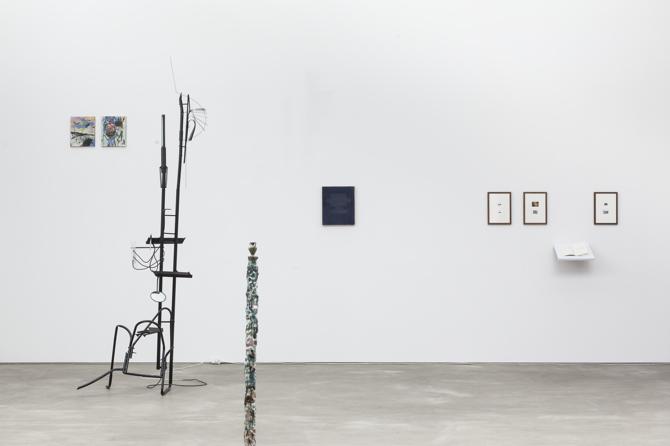

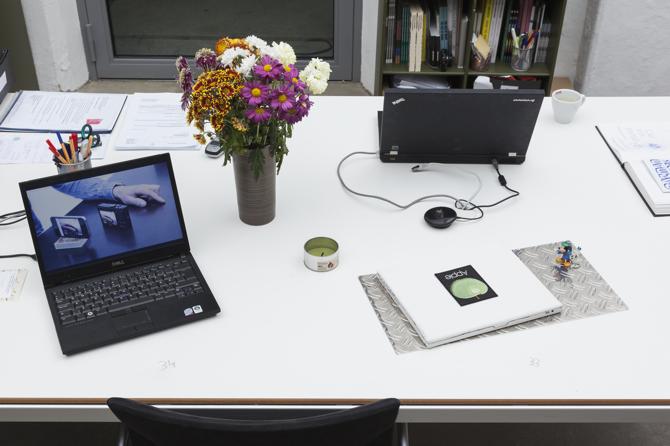
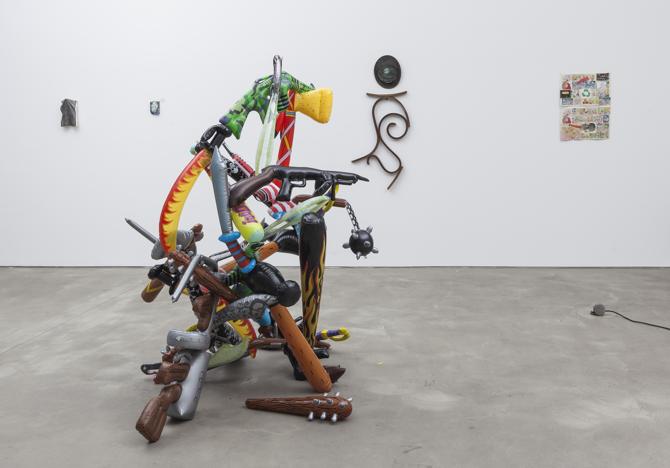

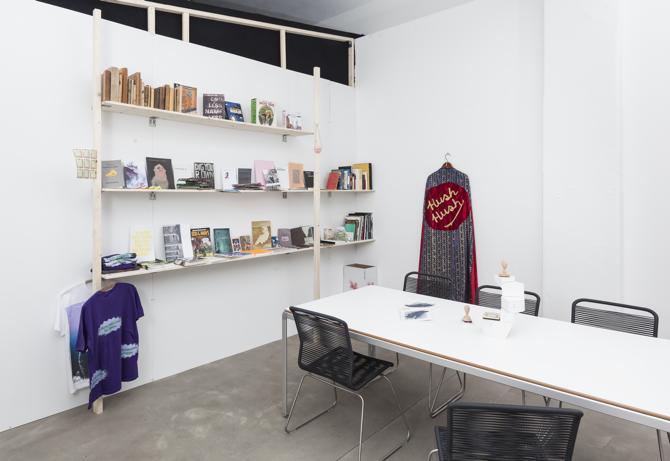

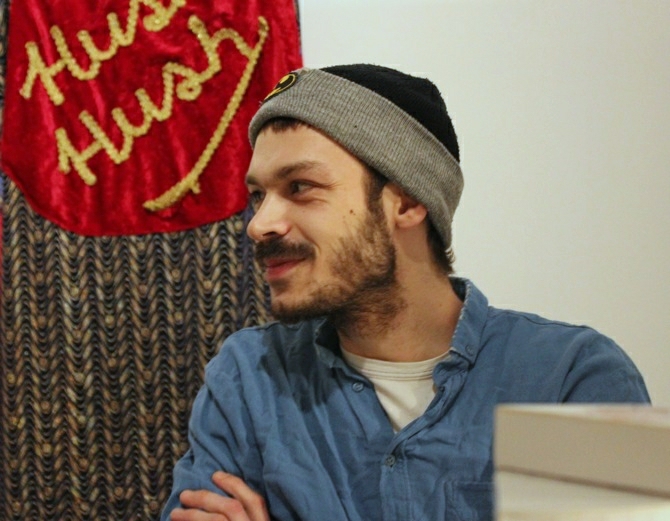
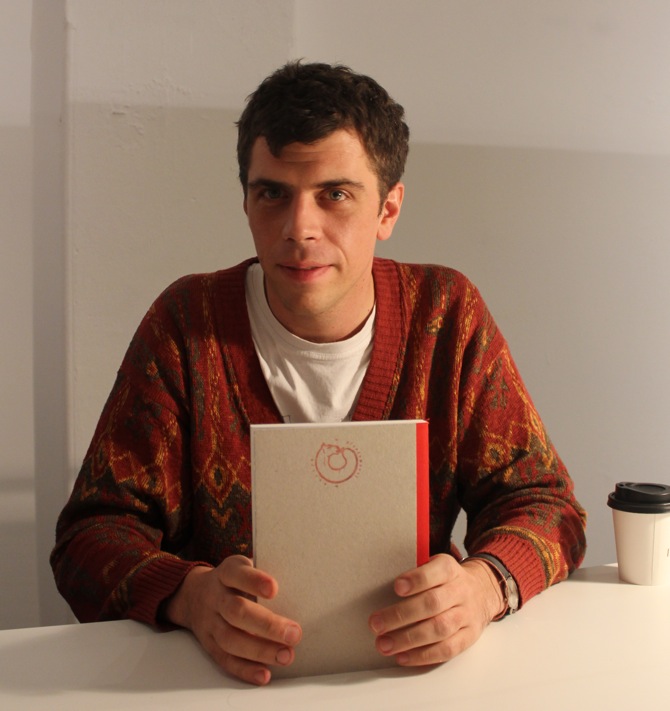 images: (1-6) installation views, BATMAN ELEKTRONIK, Galerie Mikael Andersen Berlin, Curated by Fritz Bornstück & Ernst Markus Stein, photos and courtesy Galerie Mikael Andersen // (7) portrait Ernst Markus Stein, photo by artfridge // (8) portrait Fritz Bornstück, photo by artfridge
images: (1-6) installation views, BATMAN ELEKTRONIK, Galerie Mikael Andersen Berlin, Curated by Fritz Bornstück & Ernst Markus Stein, photos and courtesy Galerie Mikael Andersen // (7) portrait Ernst Markus Stein, photo by artfridge // (8) portrait Fritz Bornstück, photo by artfridge